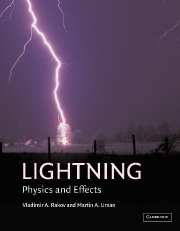Book contents
- Frontmatter
- Contents
- Preface
- 1 Introduction
- 2 Incidence of lightning
- 3 Electrical structure of lightning-producing clouds
- 4 Downward negative lightning discharges to ground
- 5 Positive and bipolar lightning discharges to ground
- 6 Upward lightning initiated by ground-based objects
- 7 Artificial initiation (triggering) of lightning by ground-based activity
- 8 Winter lightning in Japan
- 9 Cloud discharges
- 10 Lightning and airborne vehicles
- 11 Thunder
- 12 Modeling of lightning processes
- 13 The distant lightning electromagnetic environment: atmospherics, Schumann resonances, and whistlers
- 14 Lightning effects in the middle and upper atmosphere
- 15 Lightning effects on the chemistry of the atmosphere
- 16 Extraterrestrial lightning
- 17 Lightning locating systems
- 18 Deleterious effects of lightning and protective techniques
- 19 Lightning hazards to humans and animals
- 20 Ball lightning, bead lightning, and other unusual discharges
- Appendix: Books on lightning and related subjects
- Index
19 - Lightning hazards to humans and animals
Published online by Cambridge University Press: 05 June 2013
- Frontmatter
- Contents
- Preface
- 1 Introduction
- 2 Incidence of lightning
- 3 Electrical structure of lightning-producing clouds
- 4 Downward negative lightning discharges to ground
- 5 Positive and bipolar lightning discharges to ground
- 6 Upward lightning initiated by ground-based objects
- 7 Artificial initiation (triggering) of lightning by ground-based activity
- 8 Winter lightning in Japan
- 9 Cloud discharges
- 10 Lightning and airborne vehicles
- 11 Thunder
- 12 Modeling of lightning processes
- 13 The distant lightning electromagnetic environment: atmospherics, Schumann resonances, and whistlers
- 14 Lightning effects in the middle and upper atmosphere
- 15 Lightning effects on the chemistry of the atmosphere
- 16 Extraterrestrial lightning
- 17 Lightning locating systems
- 18 Deleterious effects of lightning and protective techniques
- 19 Lightning hazards to humans and animals
- 20 Ball lightning, bead lightning, and other unusual discharges
- Appendix: Books on lightning and related subjects
- Index
Summary
Lightning struck a supporting steel pole of a tent in which 26 schoolgirls, two adult supervisors, and seven dogs were sleeping. There were injuries to 23 girls, four of which were fatal, and four of the dogs died.
R.B. Anderson (2001)Statistics
The annual average death toll, according to the US National Oceanographic and Atmospheric Administration (NOAA) publication Storm Data, for each of the four major storm-related hazards, floods, lightning, tornadoes, and hurricanes, is given in Fig. 19.1. Interestingly, warnings and similar forecast products issued by the US National Weather Service generally cover only floods, tornadoes, and hurricanes, three of the four most important causes of storm-related fatalities (Holle et al. 1999). The fourth cause, lightning, is, however, the second most efficient weather-related killer in the United States.
According to Storm Data, the average number of deaths per year from lightning in the United States from 1966 through 1995 was 85 (Fig. 19.1). Distributions of lightning deaths and injuries by the place of occurrence are shown in Fig. 19.2. Over 30 percent of all lightning deaths involve people who work outdoors, mostly farmers and ranchers, and over 25 percent involve outdoor recreationists (Uman 1986, Table 3.1). The Storm Data statistics are primarily derived from newspaper clippings describing weather-related injury and death. Shearman and Ojala (1999) compared the statistics in Storm Data Summary (an adjunct to Storm Data) with those from the Michigan Department of Public Health Records and found that the Storm Data Summary reported 17 percent fewer lightning mortality cases in Michigan, during 1978 to 1994, but slightly more lightning injuries. Lopez et al.
- Type
- Chapter
- Information
- LightningPhysics and Effects, pp. 642 - 655Publisher: Cambridge University PressPrint publication year: 2003



